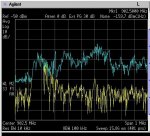Exactly. BTW, there are no 900 MHz public safety frequencies, however, there is a 900 band for commercial and utility use that has resulted in surplus gear which hams have used in the ham 900 band.
The original questions were: " How does 900 MHz compare to 440 Mhz for local reliable range? Does antenna gain and lower noise floor make up for greater path loss? "
Each band has different propagation characteristics. There have been several good responses from people who have compared the two bands. I have also had repeaters on both440 and 902. We got the 902 off to a good start with surplus equipment from Nextel as well as MSF repeaters and high gain base antennas from defunct paging operations.
In the metro and suburban areas, the 900 band is so infested with wireless widgets that the "noise floor" was aweful and repeater talk-in coverage was severely degraded. At its best, the 900 was fun and something different to play with but 440 coverage was always better from the same sites.
I understand that some amateur systems have been successful in avoiding the high noise floor by using the repeater receive frequency closest to the band edge. Pretty much all of the wireless devices are cheap and not equipped with accurate frequency determination so they intentionally stay away from the edge to insure that they don't go outside the band.
This spectrum analyzer view of the "noise floor" at one of our sites shows the lower noise near the band edge.
This is a screen capture from an Agilent ESA-E analyzer preceded by a high gain LNA and a 900 preselector filter. The yellow trace is the 'live' trace and the blue trace is a peak hold.
The noise function marker at 902.5 MHz is showing a current value that is more than 14 dB higher than the thermal noise. By comparison, the "noise floor" at many 800 MHz public safety sites does not exceed the thermal noise.



